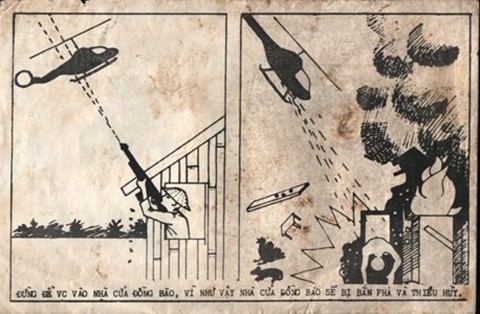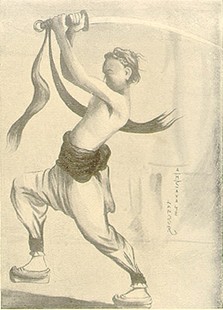In our never-ending quest to improve Microkhan Jr.’s rudimentary dancing skills, we’ve recently had to call out the big gun—the oeuvre of the Godfather of Soul. In doing so, we stumbled across the gem above, apparently taken from one of Mr. Brown’s early television appearances (back when he treated the medium with far more seriousness). Well worth your two minutes, as is the rest of the poster’s channel—particularly this Archie Bell & The Drells clip from way back when.
The Tuxedo Years
December 10th, 2009
As the Haus Turns
December 10th, 2009
 Has any architectural innovation been as unfairly maligned as the revolving restaurant? Call such establishments as the Restaurant Skyline Mannheim and Yanggakdo Hotel kitsch if you must, but we rather like the idea of spinning around while feasting on serviceable victuals. Think of it as a sub-gourmet celebration of man’s aptitude for making grand machines.
Has any architectural innovation been as unfairly maligned as the revolving restaurant? Call such establishments as the Restaurant Skyline Mannheim and Yanggakdo Hotel kitsch if you must, but we rather like the idea of spinning around while feasting on serviceable victuals. Think of it as a sub-gourmet celebration of man’s aptitude for making grand machines.
So imagine our pleasure upon discovering that our species has actually flirted with the idea of bringing revolving restaurant technology into the modern home. As detailed in Chad Randl’s Revolving Architecture: A History of Buildings That Rotate, Swivel, and Pivot, the German industrial designer Luigi Colani played with the idea quite seriously a few years back:
In the early 1980s, Colani developed a plan for a high-density urban development called BioCity. Assuming the shape of a supine human body, its concentrated center resembled the head and torso, with more narrow residential districts extending outward across the landscapes like arms and legs. Each of the BioCity’s limbs was to feature a pair of opposing terraces extending up the banks of a central waterway and populated with over 15,000 individual homes. Intended for construction near Asia’s megacities, the individual BioCity houses were designed to derive the maximum amount of usable space from an extremely small footprint. The interior consisted of a primary room with a turntable divided into three sections, each with furnishings and appliances corresponding to a different room function…
Only one of the turntable’s three sections was accessible at a time. The section in use opened onto the primary room with its large glass wall and narrow partitioned toilet and storage space in the back corner. With the turntable rotated to open a particular section to the primary room, that space was effortlessly adapted to a variety of uses depending on the time of day and the needs of the occupant. “Why lose valuable space through halls and corridors when all the rooms you need can be built back-to-back and attainable at the touch of a button?” the designer asked.
Alas, the great era of planned cities seems to have passed us by, so it’s highly unlikely that some government will ever hire Colani to implement his scheme. How we wish he’d been in the running to help build Brasilia.
Comments Off on As the Haus TurnsTags:architecture·Brazil·Germany·Luigi Colani·North Korea·revolving restaurants·Rotor Haus·urban design
The Tech of Why You’re Fat
December 9th, 2009

The graph above shows the roughly quarter-century trend in America’s per-capita fat consumption. To our great non-surprise, we’ve became rather fond of gorging on foodstuffs that we know to be deleterious to our waistlines, though we’re heartened to see that we’ve recently pulled back somewhat from the Popeyes-related brink.
Perhaps this trend has less to do with willpower, though, than the fact that science has darn nigh perfected the art of deep frying in recent years. Think it’s easy to pack both maximum taste and calories into a disc of pressed-together poultry parts? This passage from the not-to-be-missed Breaded Fried Foods should convince you otherwise:
A conceptual schematic of heat and mass transfer in the chicken nuggets is shown in Figure 2.3. A quarter symmetric sample model was partitioned into 330 triangle elements with 187 nodes using the automatic mesh generation of the FEMLAB software with the maximum element size of 1/15 of the maximum axis parallel distance in the sample geometry and the element growth rate as 1.3 (the maximum rate at which the element size can grow 30% from a region with small elements to a region with larger elements).
If similar scientific ingenuity were diverted from chicken-nugget production to space travel, would we have a colony on Mars within the next three years? We reckon so.
The Mathletes’ Revenge
December 9th, 2009

We’re eternally fascinated by athletes whose skills are so spectacular, the powers-that-be of their respective sports feel compelled to change the ground rules in order to preserve some modicum of fairness. (See: Wilt Chamberlain and the widening of the lane, the recent “Tiger Proofing” of golf courses.) Now something similar is going on in the world of low-brow blackjack, and we must say we sympathize with the small fry on this one:
Grand Victoria Casino and Resort in Rising Sun, supported by the association that represents 11 of the state’s 12 casinos, last week asked the Indiana Supreme Court to overturn a lower court ruling that forces them to allow Thomas Donovan to play blackjack, even though the Indianapolis man admits he is counting cards…
Donovan’s case stems from a blackjack game at the Grand Victoria in June 2006. Casino staff spotted him counting cards and barred him from playing.
Donovan filed suit in September 2007, and Marion Superior Court Judge Robyn Moberly ruled in favor of the casino.
But on Oct. 30, the Indiana Court of Appeals overturned Moberly’s decision, allowing Donovan and other card counters access to the state’s casinos.
The three-judge panel said Indiana has no law, rule or regulation that prohibits card counting at the state’s casinos. Until the laws or regulations change, the court ruled, card counters have the right to play.
This strikes us as a slam-dunk win for the plaintiff, a retired programmer who clams his math wizardry nets him a relatively paltry $6,000 each yeat at Indiana’s gaming tables. Casinos shouldn’t enjoy the same rule-changing latitude as professional sports leagues, since the nature of their contract with players is quite different—they take money, rather than pay out regular salaries. Plus they’re in the business of providing entertainment to the players themselves, not to spectators, which means they’re under no obligation to make their games more watchable.
By the way, we once tried counting cards at a blackjack table. Though Donovan claims the feat is so easy a seventh grader could do it, we got completely lost. The four Long Island Iced Teas we consumed during our session probably didn’t aid our concentration.
→ 8 CommentsTags:alcohol·blackjack·gambling·Indiana·mathematics
Stealing a Day
December 8th, 2009
We need this afternoon to focus on a secret major project (to be discussed openly in this space soon, or so we hope). Wish us luck in trying to mimic the awesome, borderline hypnotic productivity of the Adept Quattro s650H, without which the world couldn’t be suitably awash in Kit Kats.
Psyops on Thin Dead Trees
December 8th, 2009

The advent of electronic media has apparently done little to diminish the use of propaganda leaflets during wartime. Over the first six weeks of the Iraq War, for example, the United States Air Force dropped 31.8 million leaflets, primarily geared toward encouraging conscripts to surrender and oil workers to resist scorched-earth orders. This June 2003 report claims the Iraqi leafleting was a worth the investment, though its evidence is strictly anecdotal. And that got us wondering as to whether anyone’s ever conducted an in-depth study of this particular brand of psyops, or if it’s just something that’s been done on faith since the advent of the airplane.
Our curiosity led us to a fascinating artifact of military scholarship: “Some Psychological Lessons from Leaflet Propaganda in World War II,” published 60 years ago in The Public Opinion Quarterly. The author was the lead writer for all of the American military’s World War II leaflets, and so thus could be expected to know a thing or two about the practice. And after debriefing scores of German civilians after the conflict ended, he drew some rather pointed conclusions about the limits of leafleting:
By far the most important category of targets, however-in point of numbers, at least-is the civilian population that can do nothing to end the war, consisting as it does of persons who cannot even remove themselves from the impact of bombing attacks. To threaten them-however gratifying
it may be to the enemy-hating propagandist-is psychologically unsound. Rather, the propagandist must seek, by continuous analysis of the patterns of life in the enemy country, to discover those actions which the enemy civilian can reasonably take in his own interest, and where his own interest coincides with ours. To find such actions may afford the key to propaganda to enemy civilians. In the absence of that key, most propaganda directed to enemy civilians will have little concrete effect on the course of a war. In fact, when it is considered that military defeats in any event constitute psychological blows of the first magnitude against the enemy civilian, it would seem that, prior to the time when mutual-interest situations begin to obtain, little can be gained from propaganda directed toward enemy civilians in wartime, except by way of building up credibility. Thus our enormous leaflet output which was dropped on Germany during the war, on which so little evidence of effectiveness has been obtained, can really be judged only in terms of whether it built up belief in our essential honesty. This confidence was needed in the final months of the war when we were in a position to exploit mutual-interest situations.
In other words, the only leaflets that have demonstrably positive results are those which a) clearly explain to civilians what they should do to better their lot, and b) list the reasons why such risks are worth taking. The blood and guts stuff, by contrast, is simply self-defeating.
A great compendium of leaflets dropped over Cambodia can be found here. And don’t miss this archive from the Malayan Emergency.
(Image via the Vietnam Helicopter Pilots Association)
→ 7 CommentsTags:Cambodia·Malaysia·military·propaganda·psychology·Vietnam·World War II
The Benefits of Complexity
December 7th, 2009
We recently stumbled across the tale of the Choctaw code talkers, who were briefly employed by the American Expeditionary Force during World War I. Upon learning of their role in the conflict, we immediately wondered why the United States military opted to use Navajos rather than Choctaws during the wider war that followed a quarter-century later. Surely it wasn’t with Ben Yahzee’s future acting career in mind.
As it turns out, Choctaws were used in limited numbers during World War II, but only for tactical assignments. The most important cryptological tasks were given to Navajos because the Marines had the utmost respect for the Axis’ code-breaking abilities, and thus wanted to use the most complex Indian language available:
“Sounds [in Navaho] must be reproduced with pedantic neatness…almost as if a robot were talking,” wrote anthropologist Clyde Kluckhohn. ‘The talk of those who have learned Navaho as adults always has a flabby quality to the Navaho ear. They neglect a slight hesitation a fraction of a second before uttering the stem of the word.” A hint of its complexity may be seen in some of its verb forms, on which it insists. The stems of many Navaho verbs differ with the object acted upon. Thus one stem must be used with long objects (pencils, sticks), another with slender flexible objects (snakes, thongs), and still others with granular masses (sugar, salt), things bundled up (hay, bundles of clothing), fabrics (paper, blankets), viscous objects (mud, feces), bulky round objects, container-and-contents, animate objects, and so forth. An entirely different verb form concerns itself with the manner of knowing an event. For example, a Navaho must use one form if he himself is aware of the actual start of rain, another if he believes that rain was falling for some time in his locality before he noticed it, and so on. “Because so much is expressed and implied by the few syllables that make up a single verb form, the Navaho verb is like a tiny imagist poem.” Thus “na’ildil” means, “You are accustomed to eat plural separable objects one at a time.”
If you find yourself undaunted by the above description, you can start teaching yourself Navajo by using one of these handy books. We have a feeling that Coyote Steals Water Monster’s Baby is a tremendous read, not to mention a bargain at only $8.
→ 9 CommentsTags:Choctaw·cryptology·language·Native Americans·Navajo·World War I·World War II
Words to Flail By
December 7th, 2009

A Thursday comment thread led us to unearth a true Web gem: an English translation of the Ruhnama, the textbook authored by the late Saparmurat Niyazov, better known to the world as the megalomaniacal dictator Turkmenbashi. The tome was infamously the only source of history and philosophy instruction for pupils during Turkmenbashi’s ruinous reign, a fact which probably goes a long way toward explaining why so many of the nation’s young’uns are desperate to study abroad.
Having thumbed through all glorious 281 pages, we can only say that Niyazov could really, really have used an editor to teach him the art of the segue—as well as the fact that too many exclamation points tend to undermine one’s literary cause. Take a look at one of our favorite passages—absolutely no changes made by us:
The human is not the only interacting, communicating and thinking living creature in the world! All living things and animals are able to perform some mental process or communicate in the world! All plants can interact among themselves; they know how to process messages in some ways conveyed to them too!
After ruthless attacks [by] Chenghis Khan, the Turkmens spun a circle of development from East to West. Turkmenistan was the most developed country in the world.
The first type of carriage was devised by the Turkmen. It served to make much work of the army and the state easier.
There is also a fantastic meditation on the importance of smiling on page 234. Highly recommended.
(Image via Begemot’s Flickr stream)
→ 6 CommentsTags:dictatorship·education·Ruhnama·Turkmenbashi·Turkmenistan
The Loss of Mike Figgis
December 4th, 2009
On one of our first-ever dates with the Grand Empress, we were smitten by the depth of her hostility toward The Loss of Sexual Innocence, arguably the most annoying, self-consciously bizarre film ever committed to celluloid—and thus prime fodder for the return of our semi-beloved Bad Movie Friday feature.
Now, don’t get us wrong—we sorta love the fact that director Mike Figgis chose to go the head-scratching route after the commercial success of Leaving Las Vegas. If he’d so desired, he could’ve made a fortune directing mainstream schlock until he was ready for the grave. Instead, Figgis decided he wanted to be an avant-garde master, and he’s paid the price—just check out what he’s been working on these past few years.
That said, The Loss of Sexual Innocence is not recommended for anyone with an aversion to pretension. We were going to quote from one of the innumerable pans that accompanied the film’s 1999 release, but none of the pros could beat this Netflix user’s lethal review:
I expect you will love or hate this movie. Imagine this sequence: A lady is slicing carrots. Her husband comes up behind her, fondles her breasts, and has sex with her from behind, all the while she keeps slicing the carrots. Then she dreams she is doing some strange quasi-strip-tease in front of a string quartet with her husband watching. He dreams a mime is shouting at him in a train station. He shoves the mime down; the mime comes back and stabs him. If that sequence sounds like an intriguing deep psychological drama, you will love this. If you are like me, you will think this was all some pseudo-intellectual pyscho-babble trying to make some social statement about the exploitation of third world countries compared to Adam and Eve getting expelled from Eden. I think if I were to watch this a few more times, I might be able to make at least a little sense of all the seemingly disconnected story lines, but I have no interest in re-watching it. None of the characters were at all interesting or sympathetic (except one girl cried on an airplane with a lot of turbulence after looking at a magazine-I guess that was supposed to make her the sensitive heroine). Half the movie was without dialog because of some weird classical or new age background music that intentionally blocked out all other sound. In one story line I could follow, Adam and Eve rise naked from a pond, watch each other urinate, fondle each other, see a snake, eat some fruit, have sex, get chased through a gate by police dogs and helicopters; then get jeered at by a crowd and get embarrased and try to get dressed.
Has any cinematic good ever come from having a dream sequence featuring a mime?
→ 4 CommentsTags:Bad Movie Friday·Mike Figgis·movies·The Loss of Sexual Innocence
The Immortals of Flesh
December 4th, 2009

We’ve heard surprisingly little debate about the Meat Industry Hall of Fame‘s inaugural class. The same folks who spent years droning on about the pass-catching virtues of Art Monk have uttered nary a peep about whether Paul Engler deserved enshrinement in his own version of Canton. And why no wailing and gnashing of teeth over the lack of posthumous love shown to Mahmut Aygun, the man behind the doner kebab?
One inductee we certainly can’t argue with, though, is Ray Townsend, without whom the modern hot dog would not exist. His flagship invention was the Frank-a-Matic, the world’s first automatic sausage linker, capable of spewing forth 30,000 hot dogs per hour. (Note that this machine is not to be confused with Croatian handball star Franka Matic.) We dare say the world would be a much gloomier (though perhaps somewhat healthier) place without Townsend’s ingenuity—though we doubt the globe’s porcine and bovine residents would agree with that assessment.
In case you missed the induction festivities in Chicago, there’s a photo gallery of the glitz and glamour here. We imagine the cocktail frankfurters they served at this shindig were truly first rate.
→ 3 CommentsTags:food·Frank-a-Matic·handball·meat·Meat Industry Hall of Fame·Ray Townsend·sports
“Stimulate Your Brain Like a Game of Yahtzee”
December 3rd, 2009
We’re just absolute suckers for any song that shouts out both Paul Newman and Rick Cerone. A highly recommended gem from the same Diamond D album that gave us the classic “Sally Got a One-Track Mind”.
Comments Off on “Stimulate Your Brain Like a Game of Yahtzee”Tags:Diamond D·hip-hop·music·Rick Cerone
Bulletproof: Cambodia, 1972
December 3rd, 2009

Believe it or not, the whole of journalism’s history has yet to be put on the Web. And so we found ourselves at the New York Public Library last week, manning a microfilm reader in search of tidbits from the early 1970s. In the course of panning past endless panels from newspapers of yore, we stumbled upon a delectable surprise—a worthy entry for our ongoing Bulletproof Project, which seeks to catalogue all known instances of soldiers who were led to believe that magic could protect them from modern arms.
The clip we found features a most irresistible headline: “To Ward Off Bullets, Hold Buddha in Jaws, Says Magic Officer.” An edited version of the piece is available here, via Google’s newspaper archive. But if you’re in a hurry, let us just briefly quote the most vital morsels:
Capt. Mam Prom Mony is the officer in charge of magic for the Cambodian army’s 54th Infantry Brigade.
One of his jobs is to teach soldiers how to use charms and spells to ward off Communist bullets. The majority of [Cambodian] soldiers wear necklaces wear necklaces of amulets, often wrapped inside a magical scarf blessed by a Buddhist monk. Once the shooting starts, Cambodian soldiers like to grip an image of Buddha between clenched teeth…
Mam Prom Mony points out none of these magical shields is any good if the wearer fails to observe the five basic principles of Buddhism. To be protected, a [Cambodian] soldier must not kill any living creature with the exception of Communists, not steal, not lie, not commit adultery, or have adulterous thoughts or drink alcohol.
Failure to obey these precepts invalidates all magic. “When this happens,” Mam Prom Mony declared, “we say that a man has killed himself.”
We shudder at the brilliance of Capt. Mony’s plausible deniability. And we grieve for those gullible soldiers of his whose final thoughts on this Earth must surely have been, “If only I hadn’t let lust into my heart…”
Armed Lounging in Angola
December 2nd, 2009
A secret major project beckons, so we’re off to deal for a spell. To fill the void, please enjoy this sequel of sorts to that excellent “SAS in Malaya” video that we posted a few days back. The scene this time is strife-torn Angola, but the same jaunty atmosphere remains. And if this is your bag, check out the artist’s other concoctions; we particularly admire his Bollywood-style take on post-colonial African conflict.
Tom Rakewell’s Nightmare Lives
December 2nd, 2009

As the once-sparkling metropolis of Dubai flounders, it’s worth revisiting Johann Hari’s eerily prescient, deeply disturbing take on the city-state from earlier this year. There are lots of nasty anecdotes contained therein, but none more depressing than the fact that the United Arab Emirates still imprisons debtors, a practice abandoned in the United States during the early 1830s.
We immediately wondered if the UAE had any company in continuing this practice. But search as we might, we couldn’t verify that any other nation still tosses its citizens in jail for the crime of falling behind on private debts. The most recent country to abolish the the incarceration of latter-day Tom Rakewells was the Republic of Cyprus, which did so in 2005 under pressure from international human-rights organizations.
And make no mistake, this is a human rights issue. It’s long been obvious that private individuals should not have the power to cause the imprisonment of their business associates, as this practice is too open to easy abuse—a sure road to the re-establishment of serfdom. Check out this cogent argument for the abolishment of debtor’s prisons from the U.S. Senate, circa 1828.
To be fair, though, old English debtor’s prisons did feature tennis. Though if we had to do time, we’d still prefer to serve our sentence in contemporary Norway; our tanning base could sure use some work, after all.
Child of the Raves
December 1st, 2009
We’ve been thoroughly enjoying The A.V. Club‘s week-long “Best of the ’00s” series, including today’s installment on top cinematic performances. The site’s writers certainly did the right thing by including Samantha Morton’s star turn in Morvern Callar, one of our favorite movies of all time. The ending sequence, shown above, never ceases to create a lump in our throat, though we can’t quite figure out why. Perhaps it’s because it’s one of those rare scenes in which music and chaos are used to convey a sense of total isolation, instead of joy and connection. Plus it adds a slight “was the entire movie a dream?” nuance to the enterprise.
As an aside, Lynne Ramsay simply doesn’t work enough. Can’t wait for We Need to Talk About Kevin, though we’ll have to line up some shots of happy juice right outside the theater doors. The woman is the master of the total downer.
→ 2 CommentsTags:Lynne Ramsay·Morvern Callar·movies·music·Samantha Morton
The Gulag-Free Archipelago
December 1st, 2009

Upon being presented with the map above, the first question that pops to most minds is, “Why is the incarceration rate in the United States so absurdly high?” But given our proclivity for the esoteric, we now find ourselves wondering, “Why is the incarceration rate in Indonesia so darn low?”
There is certainly no single, all-encompassing answer to that head-scratcher. There’s probably something to be said for the law-abiding nature of most Indonesians, perhaps buttressed by the importance of tight-knit families living in relatively small communities. But we suspect a big part of the answer may be the legal system’s grudging tolerance for vigilante justice, especially in areas where the police hold little to no sway. A fascinating 2006 piece on the extrajudicial killings of “sorcerers” in Java ends with this disturbing coda:
Throughout Java not only sorcerers, but also alleged wife-beaters, thieves, rapists, and so on are often violently targeted by local residents. Neighbours, family, and friends form groups to punish the accused. This can be a spontaneous reaction to an incident, but equally the measure may be planned. The violence is specifically targeted against the accused. Even if the spouse and children support or protect the accused, they are often left untouched. The punishment is summary and violent, with the corpse often being defiled. The authorities often sympathise and turn a blind eye to the punishment.
Community justice is taken for granted. Aside from pointing to the alleged wrongdoing, the participants barely articulate, rationalise, or systematically explain their actions. Yet this ad hoc, sometimes spontaneous, and frequently violent form of justice is pervasive and entrenched. No account of justice in Indonesia would be complete without analysing it.
We suspect that as Indonesia’s central government becomes more robust in the coming years, its tolerance for such community justice will diminish—which, in turn, will require the greater use of incarceration. That may not sound like a happy prospect, but no healthy democracy can allow vigilantism to rival the state. We here in the U.S. know all too well where unchecked “community justice” can lead.
Animal Rights in Lahore
December 1st, 2009
 We shudder to think how PETA might react if the organization had access to Lahore’s bustling camel market, which buzzed with more activity than usual in the runup to Eid al-Adha:
We shudder to think how PETA might react if the organization had access to Lahore’s bustling camel market, which buzzed with more activity than usual in the runup to Eid al-Adha:
The camel traders who brought camels from different cities of southern Punjab and Sindh were sold like hotcakes on Friday evening. The traders too reduced the prices almost half as compared to a week ago. A camel with earlier price tag of Rs 100,000 or above was sold at Rs 40,000 to 50,000 while the highest price did not go beyond Rs 80,000 for a good-looking camel. However, some rare giant size camels were sold a few days ago at Rs 400,000 and above.
The prices further dropped late Friday night when traders were preparing for return to their hometowns and had parked trucks close to the animals to load back the animals. The sacrificial camels were seen driven with the cart all around the City particularly on roads leading to posh areas from where most buyers came. The camels were seen howling in the markets all around, creating sympathy for them but they were mercilessly beaten and driven by their owners in search of buyers and lucrative bargaining.
Despite the pronouncement of Pakistan’s Council for Herbal Physicians, we highly doubt that the meat of these sacrificial camels is an effective balm for hepatitis C. But we remain eternally intrigued by the purported cancer-fighting properties of camel urine.
“New Villages”
November 30th, 2009
You might recall how a few years back, Britain’s anti-insurgency tactics in 1950s Malaysia were touted as a model for American forces in Iraq. That turned out to be poppycock, of course, since the British method involved tactics far too unpalatable for the post-colonial world to stomach. Among those tactics, as described in today’s edition of Malaysia’s The Star, was the forced relocation of half-a-million ethnic Chinese citizens:
“We were really innocent victims back then. The British just assumed that as long as we were Chinese, we were helping the Communists!” said Sim. “They came to our home and ordered us to start packing and dismantling our house. If we did not do it within a week, they would just burn it down.
“We had to pack up everything, including the planks and the attap; and rebuild our new house in the lot that was given to us. At the time we thought it would only be a temporary place to stay, and that we would be able to go back to our old homes once the Emergency was over. We never thought we would still be living here today!” added Sim.
Sim’s family had it good. Throughout the filming of his documentary in other parts of the country, Wong heard horror stories about villagers given 15 minutes or less to pack their belongings before the British soldiers torched their houses.
“How much can you take in 15 minutes? Everyone would be in a panic, and they would just grab whatever they could,” said the director. “Each family was then given a 40ft x 80ft (12.2m x 24.4m) piece of land within the confined area, and they had to build their own home.”
Amazingly, 450 of the 480 “New Villages” constructed in this fashion still exist. Over the border in Thailand, meanwhile, guerrillas who held out until the late 1980s were settled in much more luxurious “Peace Villages,” paid for by the Thai government. Persistence apparently has its rewards.
→ 5 CommentsTags:Britain·Communism·insurgencies·Iraq·Malaysia·military·Thailand
The Demise of “Criminal Insanity”
November 30th, 2009
 In reading about the murder of four police officers near Tacoma, we were most struck by the prime suspect’s obvious paranoid schizophrenia—a disease that seems to have been wholly untreated, in part because his family members were afraid of staging any sort of medical intervention:
In reading about the murder of four police officers near Tacoma, we were most struck by the prime suspect’s obvious paranoid schizophrenia—a disease that seems to have been wholly untreated, in part because his family members were afraid of staging any sort of medical intervention:
As part of the child-rape investigation, the sheriff’s office interviewed Clemmons’ sister in May. She told them that “Maurice is not in his right mind and did not know how he could react when contacted by Law Enforcement,” a sheriff’s report says.
“She stated that he was saying that the secret service was coming to get him because he had written a letter to the President. She stated his behavior has become unpredictable and erratic. She suspects he is having a mental breakdown,” the report says.
Deputies also interviewed other family members. They reported that Clemmons had been saying he could fly and that he expected President Obama to visit to “confirm that he is Messiah in the flesh.”
This got us thinking about how a man like Clemmons would have been handled by the law in an earlier age—specifically the days when “criminal insanity” was considered a legitimate psychiatric diagnosis, and one that was used to shift people out of the legal system and into the medical establishment. This was not done in order to offer treatment, but rather to shunt ostensibly incorrigible “lunatics” into a system from which there was no formal release procedure. It was essentially an extralegal workaround, creating a parallel prison system exempt from standard oversight.
At times like these, it’s easy to see the downside of abandoning this system—the criminal justice system isn’t necessarily equipped to deal with felons of Mr. Clemmons’ mentally disturbed ilk. But in briefly thumbing through the history of criminal insanity this morning, we quickly came to realize why this “solution” was abandoned long ago: it’s because communities decided to take advantage of the asylums-cum-prisons as dumping grounds for those who truly needed help, not permanent incarceration. This account from Canada’s brief experiment with criminal insanity is instructive:
According to Lichtfield, the original intent of the law for admission to the lunatic criminal asylum was undermined by the public through the criminalization of ordinary cases of insanity. This criminalization was achieved by “tacking” onto an ordinary lunatic an official charge of assault, or being dangerous to the public. In this way, the ordinary lunatic was labeled an insane offender and “committed to gaol as the preliminary step to a transfer to the Criminal Lunatic Asylum.” Lichtfield argued that this legal manipulation helped to relieve problems of accomodation for the insane of the province, and enabled municipalities close to Rockwood to avoid spending large sums of money transporting insane persons to the more distant Toronto Provincial Asylum. Finally, this rediagnosis of the ordinary insane allowed their families in the near vicinity of Rockwood to keep “their relatives as near to them, and in an asylum as covenient of access for them” as possible.
And so the concept of “criminal insanity” was abandoned because it opened the door for so many horrendous abuses by ordinary citizens intent on (for lack of a better phrase) “mental cleansing” of their communities. The cost, alas, has been that offender such as Mr. Clemmons are not so easily taken off the streets when they show signs of psychiatric distress. And thus lies the great challenge for lawmakers in coming up with a better way of balancing the rights of mentally ill individuals with the right of society to live without fear—or, at the very least, with as least fear as possible.
(Image via Philip V. Allingham)
→ 7 CommentsTags:Canada·crime·criminal insanity·law·Maurice Clemmons·psychology·Washington
Surrounded by Seeds
November 25th, 2009
 As you tuck into your fourth helping of stuffing tomorrow evening, spare a few seconds to think about some of our less fortunate brothers from history—specifically the valiant disciples of Nikolai Vavilov, who deserves a place alongside Norman Borlaug in the pantheon of agricultural saints. Vavilov spent much of his career traveling the world in search of plant genetic materials, which he stockpiled at his institute in St. Petersburg (then known as Leningrad). For his troubles, Vavilov was eventually arrested and deported to the gulag, where he died a slow death due to starvation.
As you tuck into your fourth helping of stuffing tomorrow evening, spare a few seconds to think about some of our less fortunate brothers from history—specifically the valiant disciples of Nikolai Vavilov, who deserves a place alongside Norman Borlaug in the pantheon of agricultural saints. Vavilov spent much of his career traveling the world in search of plant genetic materials, which he stockpiled at his institute in St. Petersburg (then known as Leningrad). For his troubles, Vavilov was eventually arrested and deported to the gulag, where he died a slow death due to starvation.
Yet even in their boss’s absence, his workers dedication never wavered. When the Germans began their siege of St. Petersburg in 1941, they committed themselves to protecting Vavilov’s life’s work—even at the cost of their own lives:
The scientists and curators locked themselves into the dank, unheated building, guarding the other set of seeds as well as all of their potatoes in the dark, damp conditions of the near-freezing basement. Numb with cold and stricken with hunger, the staff took shifts caretaking the seed around the clock. Nine of Vavilov’s most dedicated coworkers slowly starved to death or died of disease rather than eat the seeds that were under their care. They were not alone. Over seven hundred thousand citizens of Leningrad had died from hunger by the spring of 194, when the siege finally ended.
The valiant last stand at Vavilov’s institute is also recounted in fictional form in Elise Blackwell’s Hunger.
→ 1 CommentTags:agriculture·food·Nikolai Vavilov·Russia·World War II
Too Big to Fail?
November 25th, 2009
 In the midst of our annual Thanksgiving pigout, we’ve often justified our gluttony on the grounds that the ensuing expansion of our girth really shouldn’t be frowned upon by society. After all, isn’t the disapproval of fatness of a modern phenomenon, egged along by the Fitness Industrial Complex? In Medieval times, we tell ourselves, our massive ingestion of food would be hailed as a mark of greatness—why else would a king go along with being called Charles the Fat?
In the midst of our annual Thanksgiving pigout, we’ve often justified our gluttony on the grounds that the ensuing expansion of our girth really shouldn’t be frowned upon by society. After all, isn’t the disapproval of fatness of a modern phenomenon, egged along by the Fitness Industrial Complex? In Medieval times, we tell ourselves, our massive ingestion of food would be hailed as a mark of greatness—why else would a king go along with being called Charles the Fat?
Alas, it seems we’ve been mistaken all these years, and that obesity has been frowned upon for many a century. A fascinating (albeit decade-old) piece from Nature breaks down how the denizens of Medieval Japan and European viewed their more rotund compadres:
It has been proposed that today’s harsh judgements of obese persons in the West are a modern development and that, in an earlier, more enlightened era, corpulence was highly regarded. The paintings of fleshy women by artists such as Rubens and Renoir are often cited in support of this view. But the products of these artists may tell us more about the interests of their patrons than about popular attitudes. When we turn to these attitudes, a different and less flattering picture emerges, with gluttony as a key feature.
We were especially intrigued by the paper’s section on Japan, a nation which recognized the food-obesity link several centuries in advance of the West. There, corpulence was seen as karmic payback for those who disobeyed Buddhist tenets—or, as in one recounted incident, simply enjoy consuming “between 50 and 60 pieces of sushi topped with ayu fish.”
Comments Off on Too Big to Fail?Tags:food·Japan·Medieval history·obesity·sushi·Thanksgiving
Stoned and Dethroned
November 24th, 2009
We can honestly say we’ve never once been tempted to try phencyclidine. Nothing about the drug seems enjoyable in the slightest, starting with the fact that it tends to make grown men strip off all their clothes and rant like lunatics. (Exhibit A: Steve.) That said, it’s always nice to have cinematic confirmation that our “Just Say No” approach to angel dust is, indeed, correct. And so we were recently pleased to come across Death Drug, starring a pre-Miami Vice Philip Michael Thomas. We realize that Thomas isn’t exactly renowned as the Sir Laurence Olivier of his era, but he’s very effective in the scene above—the man freaks out in a grocery aisle far better than he sings.
→ 2 CommentsTags:Death Drug·drugs·movies·PCP·Philip Michael Thomas
Bulletproof: The Boxers
November 24th, 2009
 It is to the turn-of-the-century media’s great discredit that they referred to China’s quasi-Luddite rebels as “Boxers.” Had the minions of William Randolph Hearts been more adept at understanding Chinese, they would have realized that the rebels’ secret society translated more literally as “Fists of Righteous Harmony,” a far more poetic moniker for an organization dedicated to dragging their nation back a few centuries.
It is to the turn-of-the-century media’s great discredit that they referred to China’s quasi-Luddite rebels as “Boxers.” Had the minions of William Randolph Hearts been more adept at understanding Chinese, they would have realized that the rebels’ secret society translated more literally as “Fists of Righteous Harmony,” a far more poetic moniker for an organization dedicated to dragging their nation back a few centuries.
Yet these failed anti-modernist, anti-Western rebels will forever be known to Americans as the Boxers, a name that doesn’t quite do justice to the peculiarity of their movement. Like the other groups we’ve described as part of our Bulletproof Project, the Boxers believed that they could render their bodies impervious to bullets. Their method consisted of 100 straight days of physical exercises and magical incantations, after which an inductee was considered pure enough to resist foreign rifles. And then a final ceremony sealed the deal:
Each new recruit had to undergo an initiation rite involving the learning of incantations. Once he reached the stage of being “under the spell,” he was regarded as being immune to bullets, usually demonstrated on the uninitiated by firing blank bullets at his body. These demonstrations often took place at boxing grounds established throughout the country.
What this means, of course, is that the ranking members of the Fists of Righteous Harmony knew full well that their methods didn’t work—the initiation ceremony was nothing but a con. Yet they still sent the recruits into firefights armed with nothing more than swords, since guns were considered instruments of the foreign devils.
This has always struck as the litmus test for defining a cult: do the leaders themselves believe in the principles they espouse?
A nice little collection of Boxer-related photos and artwork here. Despite being so lightly armed, the rebels were surprisingly successful in the early going due to their zeal. For some reason, that fact makes us think of the first stanza of Yeats’s “The Second Coming”.
→ 8 CommentsTags:Boxer Rebellion·China·cults·poetry·psychology·The Bulletproof Project
Failing to Prepare is Preparing to Fail
November 23rd, 2009
We generally suspect that few fake kidnappings go off without a hitch. And that’s especially true when the perpetrators of the crime don’t understand the basics of cell-phone technology:
At about 6am Friday morning Bangor Police received information that Mr. Daniel Chute was being held captive in an automobile in the Bangor Mall Cinema’s parking lot on Stillwater Avenue.
Police say these captors were demanding several hundred dollars to be wired to them and if they didn’t get the money, they would shoot Chute.
After more than two hours of cell phone company assistance using satellites to “ping” the location of the phone the victim was using.
Mr. Chute was located hanging out in a car with a male and a female in the parking lot of Burlington Coat Factory.
Though cell-phone tracking may ultimately have done in Mr. Chute’s alleged plot, we think the cops initially became suspicious because of the outrageously low ransom demand. A few hundred bucks? Sounds like Mr. Chute should have studied this chart before setting the wheels in motion.
→ 1 CommentTags:crime·kidnapping·Maine·satellites·technology
Alchemy on Shaolin
November 23rd, 2009
In terms of sheer quixoticism, the quest for kitchen diamonds ranks mighty high. Scores of swindlers, loons, and fabulists have long claimed to know the secret of manufacturing a girl’s best friend, using little more than lumps of charcoal and common ovens. (Peanut butter figures heavily in our favorite tongue-in-cheek recipe.) As with most alchemical dreams, there’s a substantial grain of truth here—industrial-grade diamonds can be created with controlled explosions, and synthetic diamonds can be cooked up in certain laboratories. But anyone looking to mint money with their microwave is obviously bound for eventual disappointment.
Yet we’re still fascinated by the doggedness of those who hold onto the dream, such as a Staten Islander who opted for an unusual cover story during World War I:
Three detective-lade automobiles made their way to 51 Van Duse Street at 1 o’clock in the morning and the detectives surrounded the building, though one of the windows of which a light could be seen. A man was seen inside bending over a gas furnace and pouring some dark fluid into the melting pot. The detectives…rushed in and confronted the man who stood with arms bared and disheveled hair, over the furnace.
“Now tell us what you are doing,” demanded Eagan as the others kept a close watch.
“Making bombs,” the man replied in a stage whisper, without looking up., “The mercury-cyanide kind—ship ’em off to Germany by way of New Jersey—they use ’em in the trenches.”
His visitors did not hurry cautiously out when the man said this, and he looked up in surprise. Inspector Eagan told him who he was and was about to place the man under arrest when he burst into a laugh.
“Why, I though you were just some of the curious neighbors and that’s the way I scared them all away,” he said. I’m making diamonds. Have almost completed a process that will make me rich and had to keep the process secret by scaring people away.”
The crestfallen detectives…found several chunks of iron containing white bubbles, which the inventor said would be diamonds when the process was perfected.
We wonder at what point the “bombmaker” realized that those bubbles were a dead end?
→ 1 CommentTags:alchemy·diamonds·pseudoscience·Staten Island
Twilight of the Panthers
November 23rd, 2009

It’s been a rough year for Florida’s official animal, as 15 percent of the state’s remaining wild panthers have perished (largely due to being hit by cars). Now comes particularly grisly news out of Yeehaw Junction:
An anonymous caller reported seeing a dead Florida panther by the side of the Florida Turnpike near Yeehaw Junction. That’s more than 150 miles north of where most panthers live.
When Florida Fish and Wildlife Conservation Commission staffers checked out the tip Thursday afternoon, they discovered something more disturbing: someone had cut off the panther’s head.
On Friday the state wildlife agency offered a reward of up to $1,000 for information that could lead to the arrest of whomever took the grisly souvenir.
“To just simply whack off a panther’s head is against the law,” explained agency spokeswoman Joy Hill.
There’s also a $15,000 reward on offer for information leading to the arrest of whoever murdered a Florida panther this past April.
We hate to be pessimists about the fate of the so-called cat of God, but can any species come back from such circumstances? When we read about rebounds from the brink of extinction, the data is never quite as grim as it is for the Florida panther—just 100 animals left in the wild, and no indication that their main killer (motor vehicles) will become less lethal any time soon. If anything, accidents look certain to increase, as older males roam farther afield in search of food.
The best model for recovery may come from the black-footed ferret, whose population shrank to as little as 120 before rebounding to a few thousand today. But panthers strike us as far too rambunctious to lasso into captive breeding programs.
→ 2 CommentsTags:animals·black-footed ferrets·Florida·panthers·wildlife management
First Contact: The Ainu
November 20th, 2009

Every eight to ten months, we run across a story more-or-less identical to this one lamenting the declining visibility of Japan’s Ainu minority. It’s certainly a sad tale, given that forced assimilation was the nation’s official policy throughout much of the twentieth-century. Yet the Ainu have received equally callous treatment from the West, particularly at the notorious 1904 World’s Fair in St. Louis. There, a bevy of Ainus were “imported” to hang out at an ethnographic exhibit, much like zoo animals. (See above for a pair of Ainu shamans who were displayed in such a manner.) This exhibit took place just as Japan was emerging as Asia’s great power, and caused American racial theorists to fret over the plight of “Caucasians” such as the Ainu indicated that whites were “not biologically predestined to superiority.” (In a stroke of evil genius, the fair’s organizers also had the Ainu and other ethnic minorities square off in a bunch of quasi-athletic contests; Nate DiMeo has a great piece about those racial games here.)
Though the World’s Fair marked the Ainus introduction to most Westerners, the people actually first came in contact with Dutch explorers in 1634. This was during the period when Japan was close to exploration, but the Ainu’s home island of Hokkaido still wasn’t entirely under the shogun’s control. The Dutch were thus able to meet some curious fishermen, and jot down their initial impressions:
This people appears to have intelligence. Their beards are long, black, and strong. They have brown skin and their heads are shaved with the exception of a tuft of hair the size of two fingers, which rests at the front of the head. They put their hands together below their heads as a greeting. They are dressed in bear skins armed with bows and arrows…
They seem to have no government, no writing or books, and no one seems able to read or write. There appears to be bandits in some places who dominate the people. Most people have scars on their heads where they have been wounded.
Each man has two wives, who make clothing and cook for him…Both men and women like strong drink and very easily become drunken. They look wild, but they are so sincere and straightforward in their dealings with strangers that they must be considered civilized.
If you have a few moments, this brief documentary video sheds a bit more light on Ainu history and customs. Fun fact: contrary to the assumptions of American racialists, the Ainu’s DNA betrays no hint of Caucasian ancestry. But they do seem to share some genetic markers with the inhabitants of the extremely distant Andaman Islands. A result of pre-modern seafaring, or a long-ago landbridge?
Security and the Soil
November 20th, 2009
In Pakistan’s chaotic North-West Frontier Province, there’s a movement afoot to temporarily ban the sale of fertilizers containing ammonium nitrate, which are frequently used in bombmaking. (The article mistakenly fingers urea fertilizers as the target of the ban.) This got us thinking about the reasons for ammonium nitrate’s continued popularity among the world’s farmers, despite the chemical’s lethal history. We actually tackled this conundrum for Slate some years back, and found that it was mostly a matter of cost—there just wasn’t a significantly cheaper alternative at that time, and farmers (especially owners of small operations in the developing world) are highly price conscious.
Alas, things don’t seem to have changed much over the past four years, despite frequent pronouncements from the fertilizer industry that ammonium nitrate is on the way out. Last year, Honeywell claimed to have made a breakthrough, by mixing in ammonium sulfate to create an inert compound. But because the technology has to be licensed to individual manufacturers, the cost remains prohibitive for most farmers in South and Central Asia.
The American military is obviously hip to this problem in Afghanistan, where they’ve adopted the gun buyback model to curtail the supply of ammonium nitrate:
The troops are paying twice what the farmers paid for it. Thus many farmers are voluntarily turning their ammonium nitrate (usually in 50 kg/110 pound bags) in for the instant profit. Other, non-explosive, fertilizers will be made available to the farmers, at equivalent cost to ammonium nitrate. Imports of ammonium nitrate into Afghanistan will be monitored. All this won’t make it impossible for the terrorists to get the stuff, but it will be more difficult. This will result in fewer, and less powerful, bombs.
Perhaps. But in a country as corrupt as Afghanistan, we think it would be no huge feat for the Taliban to continue importing what they need—though if the NWFP ban goes through, that importation will become a wee bit tougher.
What’s needed, then, is a good reason to kill ammonium nitrate production once and for all—an equally priced alternative that produces even better results. How much of the federal government’s anti-terror billions are being committed to such R&D? We’d wager a vanishingly small amount.
→ 3 CommentsTags:Afghanistan·agriculture·ammonium nitrate·corruption·explosives·military·Pakistan·terrorism




